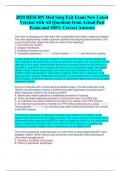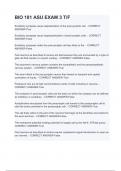2024 HESI RN Med Surg Exit Exam New Latest Version with All Questions from Actual Past Exam and 100% Correct Answers The nurse is assessing an older adult with a pacemaker who leads a sedentary lifestyle. The client reports being unable to perform activities that require physical exertion. The nurse should further assess the client for which of the following? 1. Left ventricular atrophy. 2. Irregular heartbeats. 3. Peripheral vascular occlusion. 4. Pacemaker placement. ---------- Correct Answer ---------- 1. Left ventricular atrophy. In older adults who are less active and do not exercise the heart muscle, atrophy can result. Disuse or deconditioning can lead to abnormal changes in the myocardium of the older adult. As a result, under sudden emotional or physical stress, the left ventr icle is less able to respond to the increased demands on the myocardial muscle. Decreased cardiac output, cardiac hypertrophy, and heart failure are examples of the chronic conditions that may develop in response to inactivity, rather than in response to t he aging process. Irregular heartbeats are generally not associated with an older sedentary adult's lifestyle. Peripheral vascular occlusion or pacemaker placement should not affect response to stress. During an interview with a client planning elective surgery, the client asks the nurse, "What is the advantage of having a preferred provider organization insurance plan?" Which response is best for the nurse to provide? A. Neither plan allows selections of healthcare providers or hospitals. B. There are fewer healthcare providers to choose from than in an HMO plan. C. An individual may select healthcare providers from outside of the PPO network. D. An individual can become a member of a PPO without belonging to a group. ---------- Correct Answer ----------- C. An individual may select healthcare providers from outside of the PPO network. The financial implication of selecting a provider from outside of the network is the feature most relevant to the average consumer. The nurse must have knowledge about preferred provider organizations (PPOs), which provides the option for the consumer to select a Healthcare Provider (HCP) from within the PPO network (in -network) at a reduced cost versus a higher cost for selecting an out -of-network HCP. The nurse is preparing a teaching plan for a client who is newly diagnosed with Type 1 diabetes mellitus. Which clinical cues should the nurse describe when teaching the client about hypoglycemia? A. Sweating, trembling, tachycardia. B. Polyuria, polydipsia, polyphagia. C. Nausea, vomiting, anorexia. D. Fruity breath, tachypnea, chest pain. ---------- Correct Answer ----------- A. Sweating, trembling, tachycardia. Sweating, dizziness, and trembling are signs of hypoglycemic reactions related to the release of epinephrine as a compensatory response to the low blood sugar. The 3 P's are for hyperglycemia Following diagnosis of angina pectoris, a client reports being unable to walk up two flights of stairs without pain. Which of the following measures would most likely help the client prevent this problem? 1. Climb the steps early in the day. 2. Rest for at least an hour before climbing the stairs. 3. Take a nitroglycerin tablet before climbing the stairs. 4. Lie down after climbing the stairs. ---------- Correct Answer ---------- 3. Take a nitroglycerin tablet before climbing the stairs. Nitroglycerin may be used prophylactically before stressful physical activities such as stair climbing to help the client remain pain free. Climbing the stairs early in the day would have no impact on decreasing pain episodes. Resting before or after an activity is not as likely to help prevent an activity -related pain epis ode. CN: Reduction of risk potential; CL: Synthesize The goal of nursing care for a client with acute myeloid leukemia (AML) is to prevent: 1. Cardiac arrhythmias. 2. Liver failure. 3. Renal failure. 4. Hemorrhage. ---------- Correct Answer ---------- 4. Hemorrhage. Bleeding and infection are the major complications and causes of death for clients with AML. Bleeding is related to the degree of thrombocytopenia, and infection is related to the degree of neutropenia. Cardiac arrhythmias rarely occur as a result of AML. Liver or renal failure may occur, but neither is a major cause of death in AML. CN: Reduction of risk potential; CL: Synthesize The nurse is assessing a client with chronic myeloid leukemia (CML). The nurse should assess the client for: 1. Lymphadenopathy. 2. Hyperplasia of the gum. 3. Bone pain from expansion of marrow. 4. Shortness of breath. ---------- Correct Answer ---------- 4. Shortness of breath. Although the clinical manifestations of CML vary, clients usually have confusion and shortness of breath related to decreased capillary perfusion to the brain and lungs. Lymphadenopathy is rare in CML. Hyperplasia of the gum and bone pain are clinical manifestations of AML. CN: Reduction of risk potential; CL: Analyze The client who experiences angina has been told to follow a low cholesterol diet. Which of the following meals would be best? 1. Hamburger, salad, and milkshake. 2. Baked liver, green beans, and coffee. 3. Spaghetti with tomato sauce, salad, and coffee. 4. Fried chicken, green beans, and skim milk. ---------- Correct Answer ---------- 3. Spaghetti with tomato sauce, salad, and coffee. Pasta, tomato sauce, salad, and coffee would be the best selection for the client following a low -cholesterol diet. Hamburgers, milkshakes, liver, and fried foods tend to be high in cholesterol. CN: Basic care and comfort; CL: Apply The nurse should caution the client with diabetes mellitus who is taking a sulfonylurea (GLIPAZIDE, GLYBURIDE) that alcoholic beverages should be avoided while taking these drugs because they can cause which of the following? 1. Hypokalemia. 2. Hyperkalemia. 3. Hypocalcemia. 4. Disulfiram (Antabuse) -like symptoms. ---------- Correct Answer ---------- 4. Disulfiram (Antabuse) -like symptoms. A client with diabetes who takes any first - or second -generation sulfonylurea should be advised to avoid alcohol intake. Sulfonylureas in combination with alcohol can cause serious disulfiram (Antabuse) -like reactions, including flushing, angina, palpitati ons, and vertigo. Serious reactions, such as seizures and possibly death, may also occur. Hypokalemia, hyperkalemia, and hypocalcemia do not result from taking sulfonylureas in combination with alcohol. CN: Physiological adaptation; CL: Apply Which of the following conditions is the most significant risk factor for the development of type 2 diabetes mellitus? 1. Cigarette smoking. 2. High -cholesterol diet. 3. Obesity. 4. Hypertension. ---------- Correct Answer ---------- 3. Obesity. The most important factor predisposing to the development of type 2 diabetes mellitus is obesity. Insulin resistance increases with obesity. Cigarette smoking is not a predisposing factor, but it is a risk factor that increases complications of diabetes mellitus. A high -cholesterol diet does not necessarily predispose to diabetes mellitus, but it may contribute to obesity and hyperlipidemia. Hypertension is not a predisposing factor, but it is a risk factor for developing complications of diabetes mellitus. CN: Health promotion and maintenance; CL: Apply Which of the following indicates a potential complication of diabetes mellitus? 1. Inflamed, painful joints. 2. Blood pressure of 160/100 mm Hg. 3. Stooped appearance. 4. Hemoglobin of 9 g/dL (90 g/L). ---------- Correct Answer ---------- 2. Blood pressure of 160/100 mm Hg. The client with diabetes mellitus is especially prone to hypertension due to atherosclerotic changes, which leads to problems of the microvascular and macrovascular systems. This can result in complications in the heart, brain, and kidneys. Heart disease a nd stroke are twice as common among people with diabetes mellitus as among people without the disease. Painful, inflamed joints accompany rheumatoid arthritis. A stooped appearance accompanies osteoporosis with narrowing of the vertebral column. A low hemo globin concentration accompanies anemia, especially iron deficiency anemia and anemia of chronic disease. CN: Reduction of risk potential; CL: Analyze The nurse is teaching the client about home blood glucose monitoring. Which of the following blood glucose measurements indicates hypoglycemia? 1. 59 mg/dL (3.3 mmol/L). 2. 75 mg/dL (4.2 mmol/L). 3. 108 mg/dL (6 mmol/L). 4. 119 mg/dL (6.6 mmol/L). ---------- Correct Answer ---------- 1. 59 mg/dL (3.3 mmol/L). Although some individual variation exists, when the blood glucose level decreases to less than 70 mg/dL (3.9 mmol/L), the client experiences or is at risk for hypoglycemia. Hypoglycemia can occur in both type 1 and type 2 diabetes mellitus, although it is more common when the client is taking insulin. The nurse should instruct the client on the prevention, detection, and treatment of hypoglycemia. CN: Physiological adaptation; CL: Analyze Assessment of the diabetic client for common complications should include examination of the: 1. Abdomen.





